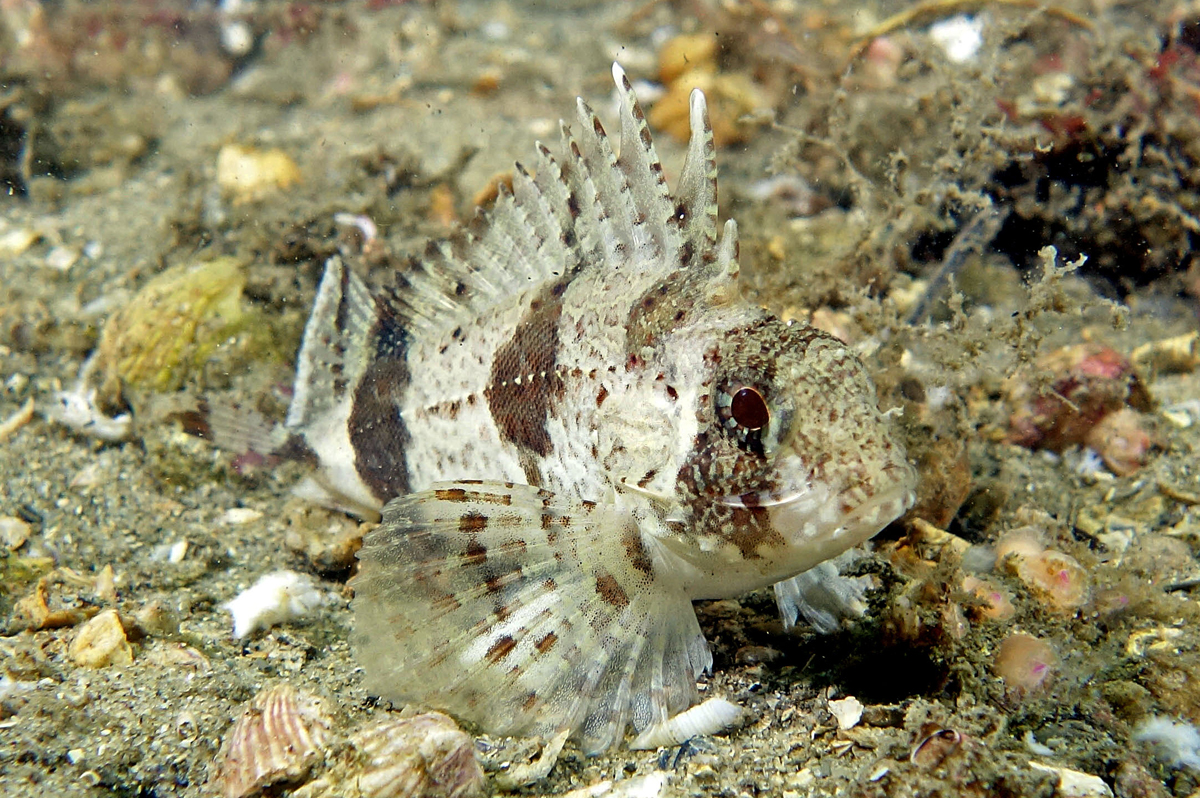Eastern Fortescue, Centropogon australis (White 1790)
Other Names: Fortesque, Fortie, Southern Bullrout, Southern Fortesque

An Eastern Fortescue, Centropogon australis, at Clifton Gardens, Sydney Harbour, New South Wales. Source: John Turnbull / Flickr. License: CC BY Attribution-Noncommercial-ShareAlike
Summary:
A small cream to brown scorpionfish with dark irregular bars on the head and along the sides, small scales covering the body, 16 dorsal fin spines and a large spine on each side of the snout that can be projected forward. The species has a broad naked area from the nape to below the anterior part of the spinous dorsal fin.
The fin spines are venomous and may inflict a very painful sting.
Video of Fortescues at Bawley Point, New South Wales.
The fin spines are venomous and may inflict a very painful sting.
Video of Fortescues at Bawley Point, New South Wales.
Cite this page as:
Bray, D.J. 2023, Centropogon australis in Fishes of Australia, accessed 02 Jul 2025, https://fishesofaustralia.net.au/home/species/3207
Eastern Fortescue, Centropogon australis (White 1790)
More Info
|
Distribution |
Eastern and southern Australia from about Fraser Island, Queensland, to the Powlett River estuary, Victoria. Inhabits sand and seagrass areas in coastal bays and estuaries. |
|
Features |
Dorsal fin XIII, 6–8; Anal fin III, 5; Caudal fin 10–12; Pectoral fin 21–24; Pelvic fin I, 5; Lateral-line scales 28–33; Gill rakers 3–4 + 8–9 = 11–14. Nasal bone on each side with 2–3 spines; supraocular ridge with 8–13 separate, well developed spines; interorbital relatively deep, depth 1.7–2.2 times in width. Scales ctenoid; broad naked area above the lateral line from the top rear of the head to below the spinous dorsal fin. |
|
Remarks |
Fortescues are sometimes seen resting motionless on sandy bottoms in large numbers. |
|
Similar Species |
The Western Fortescue, Centropogon latifrons, differs in having a deeper interorbit and occipital pit, a smaller and rounder mouth, and a narrow chevron-shaped brown band on the caudal-fin base. The Marbled Fortescue, Centropogon marmoratus, differs in having the jaw of moderate length, 15-19% SL (versus 10-15% in C. australis), relatively weak interorbital ridges, a marbled pattern on the head and body, and having a narrow naked below the spinous dorsal fin. |
|
Species Citation |
Cottus australis White 1790, Journal of a Voyage to New South Wales: 266. Type locality: between Botany Bay and Broken Bay, New South Wales. |
|
Author |
Bray, D.J. 2023 |
|
Resources |
Eastern Fortescue, Centropogon australis (White 1790)
References
Bell, J.D., Burchmore, J.J. & Pollard, D.A. 1978. Feeding ecology of a scorpaenid fish, the fortescue, Centropogon australis, from a Posidonia seagrass habitat in New South Wales. Australian Journal of Marine and Freshwater Research 29: 175–184 https://doi.org/10.1071/MF9780175
Bleeker, P 1876. Mémoire sur les espèces insulindiennes de la famille des Scorpénoïdes. Verslagen en Mededeelingen der Koninklijke Akademie van Wetenschappen (Afdeeling Natuurjunde). Amsterdam 16: 1-100 pls 1-5 (as Apistus australis)
Coleman, N. 1980. Australian Sea Fishes South of 30ºS. Lane Cove, NSW : Doubleday Australia Pty Ltd 309 pp.
De Vis, C.W. 1884. New fishes in the Queensland Museum. No. 2. Proceedings of the Linnean Society of New South Wales 1 9(3): 453-462 (described as as Tetraroge hamiltoni, type locality Moreton Bay and Tweed River, Australia) See ref at BHL
Edgar, G.J. 1997. Australian Marine Life: the plants and animals of temperate waters. Reed Books. 544 pp.
Grant, E.M. 1975. Guide to Fishes. Brisbane : Queensland Government, Co-ordinator General’s Department 640 pp.
Hutchins, J.B. & Swainston, R. 1986. Sea Fishes of Southern Australia. Complete field guide for anglers and divers. Perth : Swainston Publishing 180 pp.
Johnson, J.W. 1999. Annotated checklist of the fishes of Moreton Bay, Queensland, Australia. Memoirs of the Queensland Museum 43(2): 709-762 See ref at BHL
Johnson, J.W. & Motomura, H. 2008. Family Tetrarogidae. pp. 498-501 in Gomon, M.F., Bray, D.J. & Kuiter, R.H. (eds). Fishes of Australia's Southern Coast. Sydney : Reed New Holland 928 pp.
Kuiter, R.H. 1993. Coastal Fishes of South-eastern Australia. Bathurst : Crawford House Press 437 pp.
Kuiter, R.H. 1996. Guide to Sea Fishes of Australia. A comprehensive reference for divers and fishermen. Sydney, NSW, Australia : New Holland Publishers xvii, 434 pp.
Kuiter, R.H. 2000. Coastal Fishes of South-eastern Australia. Gary Allen. 437 pp.
Poss, S.G. 1994. Family Tetrarogidae, in Gomon, M.F., Glover, C.J.M. & R.H. Kuiter (eds). The Fishes of Australia's South Coast. State Print, Adelaide. 992 pp.
Prokop, F. 2002. Australian Fish Guide. Croydon South, Victoria : Australian Fishing Network 256 pp.
Quoy, J.R.C. & Gaimard, J.P. 1824. Chapter 8. Poissons. 183-328 pls 43-65 in Freycinet, L.C.D. de (ed.) Voyage autour du Monde, entrepris par ordre du Roi, exécuté sur les corvettes de S.M. Uranie et la Physicienne, pendant les années 1817, 1818, 1819 et 1820. Paris : Pillet Aîné Vol. 1 712 pp. 96 pls. (described as Scorpaena jacksoniana) See ref at BHL
Underhill, D. 2010. Australia's Dangerous Creatures. Reader's Digest. 368 pp.
White, J. 1790. Journal of a Voyage to New South Wales with sixty-five plates of non-descript animals, birds, lizards, serpents, curious cones of trees and other natural productions. London : Debrett 299 pp. 65 pls. See ref at BHL







